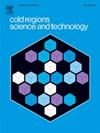Modeling axial strain-deviatoric stress response of frozen sands with enhanced LSTM approach
IF 3.8
2区 工程技术
Q1 ENGINEERING, CIVIL
引用次数: 0
Abstract
Data-driven approaches hold promise for modeling the highly nonlinear stress-strain behavior of frozen soils in comparison to standalone machine learning models which often overfit and lack generalizability. To address these issues, in this study an enhanced fundamental Long Short-Term Memory (LSTM) model with an iterative EXtreme Gradient Boosting (XGBoost) algorithm is proposed to predict the axial strain-deviatoric stress relationship of frozen sands. Using degree of saturation, mean particle size, test rate, initial void ratio, temperature, confining pressure, and axial strain as input parameters, the Local Interpretable Model-agnostic Explanations (LIME) feature-importance analysis identified initial void ratio as the most influential parameter. The adaptability of the fundamental LSTM shows better accuracy than the Random Forest (RF) model and the Multilayer Perception (MLP) model. To reduce discrepancies between predicted and measured results in the fundamental LSTM model, an uncertainty factor was introduced to improve residual accuracy, thereby facilitating the development of an XGBoost-optimized LSTM (LSTMXGBoost) model. The resulting LSTMXGBoost model demonstrated strong predictive performance for axial strain-deviatoric stress relationship across a range of triaxial shear test conditions. Analysis of results suggest that there is a good comparison between two key parameters; namely, modulus of elasticity and peak stress that were extracted from a separate triaxial test dataset not used in model training or testing. The results of this study are promising for constructing high-dimensional constitutive models that can be used in numerical simulations of frozen sands behavior for use in geotechnical engineering practice applications alleviating time consuming, cumbersome and expensive experimental test techniques.
基于改进LSTM方法的冻砂轴向应变-偏应力响应建模
与经常过拟合且缺乏通用性的独立机器学习模型相比,数据驱动的方法有望为冻土的高度非线性应力-应变行为建模。为了解决这些问题,本研究提出了一种基于迭代极限梯度提升(XGBoost)算法的增强型基础长短期记忆(LSTM)模型来预测冻沙的轴向应变-偏应力关系。采用饱和度、平均粒径、试验速率、初始孔隙比、温度、围压和轴向应变作为输入参数,局部可解释模型无关解释(LIME)特征重要性分析确定初始孔隙比是影响最大的参数。基本LSTM的自适应性优于随机森林(Random Forest, RF)模型和多层感知(Multilayer Perception, MLP)模型。为了减少基本LSTM模型中预测结果与测量结果之间的差异,引入不确定性因子来提高残差精度,从而促进了xgboost优化LSTM (LSTMXGBoost)模型的开发。所得到的LSTMXGBoost模型在一系列三轴剪切试验条件下对轴向应变-偏应力关系具有较强的预测能力。分析结果表明,两个关键参数具有较好的可比性;也就是说,从单独的三轴测试数据集中提取的弹性模量和峰值应力,而不是在模型训练或测试中使用。本研究结果有望构建高维本构模型,用于冻土行为的数值模拟,用于岩土工程实际应用,减轻耗时、繁琐和昂贵的实验测试技术。
本文章由计算机程序翻译,如有差异,请以英文原文为准。
求助全文
约1分钟内获得全文
求助全文
来源期刊

Cold Regions Science and Technology
工程技术-地球科学综合
CiteScore
7.40
自引率
12.20%
发文量
209
审稿时长
4.9 months
期刊介绍:
Cold Regions Science and Technology is an international journal dealing with the science and technical problems of cold environments in both the polar regions and more temperate locations. It includes fundamental aspects of cryospheric sciences which have applications for cold regions problems as well as engineering topics which relate to the cryosphere.
Emphasis is given to applied science with broad coverage of the physical and mechanical aspects of ice (including glaciers and sea ice), snow and snow avalanches, ice-water systems, ice-bonded soils and permafrost.
Relevant aspects of Earth science, materials science, offshore and river ice engineering are also of primary interest. These include icing of ships and structures as well as trafficability in cold environments. Technological advances for cold regions in research, development, and engineering practice are relevant to the journal. Theoretical papers must include a detailed discussion of the potential application of the theory to address cold regions problems. The journal serves a wide range of specialists, providing a medium for interdisciplinary communication and a convenient source of reference.
 求助内容:
求助内容: 应助结果提醒方式:
应助结果提醒方式:


